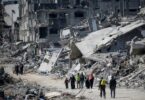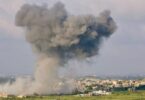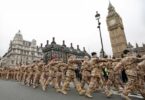Syed Zafar Mehdi
Seeking to retaliate against a US drone strike killing its top military commander, Iran’s elite Islamic Revolutionary Guards Corps (IRGC) fired multiple missiles at two US military bases in Iraq early on Wednesday.
The US Central Command admitted that 15 missiles had been fired at two targets, 10 of which struck the Ain al-Assad airbase and one Erbil, while four others failed. It denied reports of any casualties. The strikes came in the wake of the killing of General QassemSoleimani, who headed the Islamic Revolutionary Guards Corps’ (IRGC) Quds Force, and his close aides including the deputy head of Iraq’s Popular Mobilization Units (PMU), Abu Mahdi al-Muhandis, outside Baghdad airport on Friday.
Iraq’s state-run Security Media Network said in a written statement that 22 missiles had fallen on Iraqi territory. “Seventeen of these rockets hit Ain Al-Assad airbase […] and five missiles fell on Erbil city,” the network said.
US military and intelligence officials, according to Iranian authorities, were unable to track the launches as radar facilities had been destroyed in the attack. Though initial reports suggested that some Iraqis were killed in the attack, security officials in Baghdad told media that there had been no casualties among Iraqi forces.
Warning and preparation: The secretary of Iran’s top security body, the Supreme National Security Council (SNSC), said on Tuesday that at least 13 scenarios for the “revenge” had been discussed in the council.
“The response is likely to be triggered by medium-range and long-range missiles,” he asserted, adding that the 19 US military bases surrounding Iran in the region could be potential targets. US President Trump took to Twitter following the attacks to announce “all is well”.
“Missiles launched from Iran at two military bases located in Iraq. Assessment of casualties & damages taking place now. So far, so good! We have the most powerful and well equipped military anywhere in the world, by far! I will be making a statement tomorrow morning,” he said.
Iran’s missile might: While Iran’s counterstrike was a foregone conclusion, experts say the US underestimated Tehran’s capability to inflict damage on its facilities in the region. “They should have been more prepared and able to intercept the attacks, considering they have the most sophisticated technology in the world,” said Humayun Rabiei, a defense analyst, adding that Iran had massively improved its missile defense power over the years.
Defense experts told Anadolu Agency that Iran upgraded missiles with ranges of more than 1,930 kilometers (1,200 miles), encompassing all US military bases in the region. “If the US decides to retaliate against the (Ain) al-Assad attack, Iran possesses the ability to launch a severe counterstrike that may target other US bases, damage the assets of US allies in the Persian Gulf, or attack Israel,” said Rabiei. Iran’s “vastly improved” missile technology, experts argue, “is a result of efforts launched more than a decade ago under the supervision of the country’s supreme leader.”
Iran’s missiles had previously been offshoots of Soviet-era Scud rockets used in the Iran-Iraq war in the 1980s. After the war ended, Tehran focused on developing more sophisticated missile systems and enhancing older models, they note. These efforts and investments have resulted in multiple short, medium and long-range missiles, some of which were used in Wednesday’s attack.
Some of the weapons in defense circles include the short-range surface-to-surface Qiam and Fateh-110 missiles, as well as the anti-ship Nasr 1, medium-range Meshkat and air-launched Ya-Ali. “While these missiles may not be able to reach the US mainland from Iran, they can target US facilities in the region,” say analysts. They went on to note that “Tehran can also use proxies to target US forces and their allies in the Middle East.”
The way ahead: Trump will be issuing a statement on Wednesday to outline Washington’s response to Iran’s attacks. Iranian Foreign Minister JavadZarif has hinted that the operation was “over” for Iran. “Iran took & concluded proportionate measures in self-defense under Article 51 of UN Charter targeting base from which cowardly armed attack against our citizens & senior officials were launc-hed,” he said on Twitter. “We do not seek escalation or war, but will defend ourselves against any aggression,” he added.
The IRGC’s official statement addressed to the people of the US, asking them to ensure American troops vacate their bases “in order to prevent more damage”. “Do not let them to endanger the American troops’ lives by participating in warmongering policies of the inhumane regime of America,” read the statement. Iranian President HasanRouhani’s senior advisor Hesameddin Ashena warned against “any adverse military action” by the US, saying it would be met by “all-out war across the region”.
Political commentator Sayed Mohammad Marandi, who was part of the team that negotiated the 2015 nuclear deal, said “all US troops should immediately leave the U.A.E., Saudi Arabia, Bahrain and other counties where US bases are seen as a threat to Iran.” “If the Trump regime makes a foolish move, these regimes will be held responsible,” he concluded.






